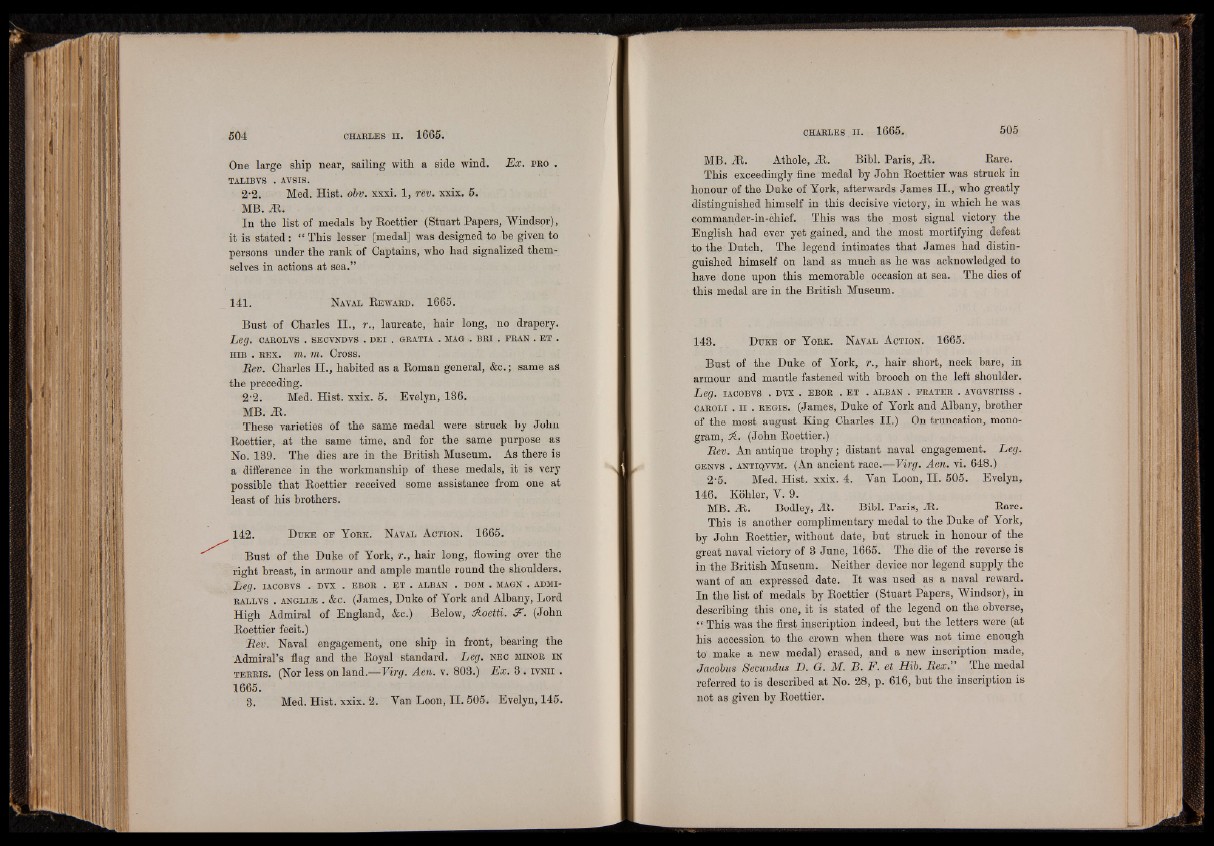
One large ship near, sailing with a side wind. Ex. pko .
TALIBVS . AYSIS.
2-2. Med. Hist. obv. xxxi. 1, rev. xxix. 5.
MB. At.
In the list of medals by Roettier (Stuart Papers, Windsor),
it is stated: “ This lesser [medal] was designed to he given to
persons under the rank of Captains, who had signalized themselves
in actions at sea.”
141. N aval R ew a r d . 1665.
Bust of Charles II., r., laureate, hair long, no drapery.
Leg. CABOLVS . SECVNDVS . DEI . GRATIA . MAG . BRI . FRAN . E T .
h i b . r e x . m. m. Cross.
Rev. Charles II., habited as a Roman general, &c. ; same as
the preceding.
2*2. Med. Hist. xxix. 5. Evelyn, 136.
MB. At.
These varieties of the same medal were struck by John
Roettier, at the same time, and for the same purpose as
No. 139. The dies are in the British Museum. As there is
a diiferenee in the workmanship of these medals, it is very
possible that Roettier received some assistance from one at
least of his brothers.
142. D u k e o f Y o r k . N aval A c t io n . 1665.
Bust of the Duke of York, r., hair long, flowing over the
right breast, in armour and ample mantle round the shoulders.
Leg. iacobvs . dvx . e b o r . fit . alban . dom . magn . a dm i-
r a l lv s . an g l u e . &c. (James, Duke of York and Albany, Lord
High Admiral of England, &c.) Below, Jioetti. <F. (John
Roettier fecit.)
Rev. Naval engagement, one ship in front, hearing the
Admiral’s flag and the Royal standard. Leg. n e c m in o r in
t e r r i s . (Nor less on land.—Virg. Aen. v. 803.) Ex. 3 . iv n i i .
1665.
3. Med. Hist. xxix. 2. Van Loon, II. 505. Evelyn, 145.
MB. At. Athole, At. Bibl. Paris, At. Rare.
This exceedingly fine medal by John Roettier was struck in
honour of the Duke of York, afterwards James II., who greatly
distinguished himself in this decisive victory, in which he was
commander-in-chief. This was the most signal victory the
English had ever yet gained, and the most mortifying defeat
to the Dutch. The legend intimates that James had distinguished
himself on land as much as he was acknowledged to
have done upon this memorable occasion at sea. The dies of
this medal are in the British Museum.
143. D u k e o f Y o r k . N aval A c t io n . 1665.
Bust of the Duke of York, r., hair short, neck bare, in
armour and mantle fastened with brooch on the left shoulder.
Leg. iacobvs . dvx . e b o r . e t . alban . f r a t e r . a v g v st is s .
ca ro l i . ii . r e g i s . (James, Duke of York and Albany, brother
of the most august King Charles II.) On truncation, monogram,
A. (John Roettier.)
Rev. An antique trophy; distant naval engagement. Leg.
g en v s , a n t iq w m . (An ancient race.—Virg. Aen. vi. 648.)
2-5. Med. Hist. xxix. 4. Yan Loon, II. 505. Evelyn,
146. Kohler, Y. 9.
MB. At. Bodley, At. Bibl. Paris, At. Rare.
This is another complimentary medal to the Duke of York,
by John Roettier, without date, but struck in honour of the
great naval victory of 3 June, 1665. The die of the reverse is
in the British Museum. Neither device nor legend supply the
want of an expressed date. It was used as a naval reward.
In the list of medals by Roettier (Stuart Papers, Windsor), in
describing this one, it is stated of the legend on the obverse,
“ This was the first inscription indeed, but the letters were (at
his accession to the crown when there was not time enough
to make a new medal) erased, and a new inscription made,
Jacobus Secundus D. G. M. R. F. et Hib. Rex." The medal
referred to is described at No. 28, p. 616, but the inscription is
not as given by Roettier.